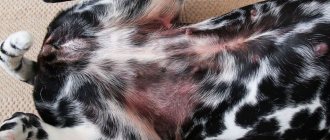If a small puppy is growing up in the house, then puddles are perceived more calmly than when puddles are left by an adult dog. This article will not discuss the topic of education; it will force the owner to be vigilant and take care of the health of his pet. Unfortunately, symptoms of urinary incontinence do not only appear in older dogs, and the symptoms cannot always be mistaken for an illness. How can you determine where a dog’s behavior is normal and where it requires immediate medical attention?
Urinary incontinence in dogs
Possible reasons
Natural reasons. Since dogs are instinctive creatures, for them “marking” with urine is a natural manifestation of the body. So what is a normal reaction and what needs to be seen by a veterinarian?
- During times of stress, fear, joy, or pain, the dog experiences severe agitation, which causes uncontrolled urination.
- A dog can also show character and be “mischievous”, making puddles for the owner - here you need to show patience and perseverance, and continue to educate the animal, because this is just a behavioral feature.
- Another feature of dogs that does not require an urgent visit to the veterinary clinic is the designation of territorial boundaries. The only thing that will help here is to reduce the sexual instinct and perform sterilization.
- Age of the animal. Muscle weakening may occur in dogs as they age, which should be monitored and maintained with ongoing medication.
- During sexual “hunting” in females, it also does not require treatment. This is a natural process associated with nagging painful spasms, which leads to frequent urination. At this time, the dog knows that you are not pleased to clean up its puddles, so do not scold your pet, but walk it more often.
- True incontinence is spontaneous urination, which cannot be corrected due to a weak contractile reflex of the urethra. This deviation is supported by medications.
Take a closer look at your pet if you notice puddles on the floor
What you need to know! If you notice signs of urinary incontinence in your dog, you should visit a veterinarian as soon as possible, since the sooner treatment begins, the higher the percentage of recovery for your pet. This disease is well treated and can be cured without a trace, only with timely access to the clinic.
Urinary incontinence caused by disease. Most often, urinary incontinence is caused by a urinary tract infection.
- Diseases of the genitourinary apparatus. Cystitis is an inflammatory lesion of the bladder caused by hypothermia or the presence of infectious parasites - chlamydia. In advanced forms of cystitis, urine with blood constantly comes out, the dog urinates in its sleep and experiences pain. To be sure of this diagnosis, the dog must be urgently taken for examination to a veterinarian, where a specialist will conduct an examination and take the necessary tests, establish the correct diagnosis, and prescribe an antibacterial course of treatment for at least two weeks. Also in dogs, urinary incontinence can be caused by urolithiasis , endometritis, urethritis, prostatitis and acute nephritis.
- Polydipsia is frequent consumption of large quantities of water. Excessive water consumption is a sign of a serious disease, which often leads to death: diabetes mellitus, pyometra, Cushing's syndrome, renal failure.
- Spinal injuries. A very difficult situation when the nerve endings of the spinal cord are destroyed, arising as a result of the breed or as a result of injury. For example, dachshunds and other breeds with elongated dorsal vertebrae suffer from incontinence much more often than other dogs, especially in older dogs. Nerve compression can also occur during the birth process. The dog must be examined by a specialist and treated, possibly with surgical intervention.
- Ectopic ureters. The disease is inherited by genes. In this deviation, the ureters do not discharge urine into the bladder, but directly into the urethra. Huskies, Labradors, retrievers, shepherd dogs, Newfoundlands, English bulldogs, corgis, and poodles are susceptible to this disease.
Puddles can be a natural manifestation or a consequence of serious pathologies
What you need to know! If a veterinarian suggests performing a surgical intervention without a diagnostic examination and preliminary treatment, then you need to say goodbye to such a “specialist.”
Weak bladder sphincter in dogs
Dogs control bladder emptying by relaxing the muscles needed to do so. But for certain reasons, sometimes the muscles weaken, and the dog is able to make a puddle in the wrong place. Since the body depends on hormones in the blood, hormones are also involved in controlling the function of urination - testosterone in males and estrogen in females. Normal concentrations of hormones inhibit urine output, while low concentrations, on the contrary, cause incontinence. In old age, with excessive weight, or removal of reproductive organs, hormonal imbalance occurs. Also, diseases of the spinal cord provoke weakening of the sphincter. Treatment for weakened sphincter is carried out with hormonal drugs.
Bladder sphincter condition
Symptoms of the disease
- A clear alarm bell will be urination in the wrong places and at unexpected times, while the dog will behave as if it had not done anything wrong.
- The appearance of unusual wet spots on the pet's sleeping place.
- Hypertrophied cleanliness - the pet’s confidence in stopping urine output if it carefully licks its genitals. This can also be detected when examining the dog; reddened areas of the skin will stand out.
What you need to know! Always carry out the full course of treatment, following strictly the instructions of the veterinarian and the instructions for medications, this way you will avoid repeated manifestations of the disease, in which the original treatment approach will no longer work.
Noticed the puddle? Then take a closer look at your pet's behavior!
Urinary incontinence as a complication after sterilization and castration
When reproductive organs are removed from dogs, the percentage of incontinence increases; some breeds are hereditarily susceptible to this disorder.
What you need to know! Urinary incontinence does not occur as a result of surgery, which may cause infection. This pathology mainly manifests itself due to hormonal imbalance in the dog’s body. If you notice symptoms indicating this disease, immediately take your dog to the clinic.
This disease may not manifest itself immediately. Within 2-3 years or even more time should pass after sterilization. It is during this period that it is necessary to closely monitor the pet’s condition, and at the first symptoms, contact the clinic immediately.
Causes of urinary incontinence in dogs
What to watch out for: Excessive water consumption
Sometimes, while observing your pet, you can notice a large amount of water consumption. And here we do not take into account the usual feeling of thirst in hot weather or from intense physical activity. There are situations that are much more serious, for example, this may be a manifestation of the development of pathology - diabetes mellitus, impaired metabolism and hormonal levels, pyometra, frequent urination.
Before you panic, it is important to make sure that the amount of water you consume is actually outside the normal range. To do this, you can independently calculate the approximate water consumption of your pet, based on a diagram that calculates the required amount of liquid per animal’s weight.
Scheme for calculating water consumed by a dog
| Dog weight, kg | Fresh drinking water, l |
| 1 kg | 0.1 l |
| 8 kg | 0.8 l |
| 10 kg | 1 l |
High water consumption may be a sign of a serious illness
Causes of urinary incontinence in dogs
According to veterinary experts,
timely contacting a veterinarian with a problem such as dog urinary incontinence can be cured in 7 out of 10 cases!
And, now imagine how many poor animals were thrown onto the street, or simply killed (some consider euthanasia a humane way of killing), only for the simple reason that their owners did not know what caused this condition in their pet, and how to can help in such a situation. To ensure that you and I do not join the ranks of such would-be owners, we provide below a list of causes of urinary incontinence in dogs. Ah, conclusions... Draw your own conclusions. Is it worth it to throw the animal out into the street or euthanize it?! So, the reasons:
- True incontinence - spontaneous release of urine or its constant leakage - is the only reason that cannot be corrected, but can be treated.
- Stress incontinence – all it takes is for your dog to become very nervous or feel a surge of joy and excitement, and he can make a puddle.
- Uncleanliness - in this case, the dog is simply not raised correctly and does not know how to ask to go to the toilet, and in this case the owner must be educated.
- Territory marking - unsterilized females and males may mark their territory during sexual activity.
- Senile urinary incontinence occurs in dogs in extreme old age and is caused by a weakening of reflex activity.
You must understand that
in the case when a dog consciously relieves itself in the room where it lives or is located, this also cannot be considered a medical problem and called incontinence. Most likely, this is done out of spite, to annoy the owner.
Well, in order to determine which of the above reasons is the cause of urinary incontinence in your dog, you need to observe the behavior of the animal, and of course, contact your veterinarian with your problem, who will be able to summarize and diagnose your problem, accordingly - give you recommendations and prescribe a course of treatment, if necessary.
However, in addition to the above reasons for urinary incontinence, this condition may also be explained by the presence of a certain disease in your dog. So, incontinence can be a symptom of such diseases
, How:
- Cystitis or urinary tract infections - this disease can be diagnosed by passing a general clinical urine test. If the diagnosis is confirmed, antibiotic therapy is prescribed for 1-3 weeks. As practice shows, just a few days after starting a course of antibiotics, if incontinence is a symptom of cystitis, urination processes are normalized. However, it is recommended to continue treatment to the end - a relapse of the disease is possible if the course of treatment is incomplete.
- Polydipsia is excessive fluid intake as a result of irrepressible thirst and, as a result, uncontrolled urine output. This condition, in turn, may indicate diseases such as (a purulent inflammatory process that occurs in the uterus), diabetes mellitus, Cushing's syndrome, diabetes insipidus, and chronic renal failure. In order to determine which disease is the root cause of your pet’s condition, it is necessary to take clinical and biochemical blood tests, a general clinical urine test, examine internal organs, and take specific functional tests.
- Pathologies of the bladder sphincter (more often occur in females) can be either congenital or acquired, as a result of age-related changes in the dog’s body, obesity, and decreased sensitivity of sphincter receptors. Treatment is symptomatic - hormonal therapy, antidepressants (they have the property of relaxing the bladder muscle and contracting the bladder neck muscle), taking alpha-agnes.
- Pathology of the ureters, when the ureter itself begins in the kidneys and, bypassing the bladder, enters either the vagina or rectum. In this case, surgical correction is prescribed.
- Damage to the spinal cord and spine in the lower lumbar region. In order to eliminate such a symptom, a surgical operation is necessary that decompresses the pinched area, which is responsible for the innervation of the sphincter and bladder.
What should you do if you notice symptoms of urinary incontinence in your dog?
Having noticed suspicious behavior in your dog, as well as puddles in the place where it sleeps, it is not enough to take action and just transfer the animal to live in the yard, provided that you live in a private house. Yes, you will save your home from unnecessary cleaning, but you will only make things worse for your pet.
There are people who want to show their love to their pet in the form of “humane” euthanasia, stipulating that the animal can no longer be helped, and it will suffer for the rest of its days if this method is not applied now. And some even throw the dog out into the street, not wanting to be puzzled by the problem of eliminating urinary incontinence in their pet. But these methods are completely inhumane and absolutely wrong!
If you have encountered this problem with your pet, then only a visit to a veterinary clinic and a competent specialist will help eliminate a lot of unpleasant consequences. Only in this way and in no other way can you show love to your pet, because he is also a member of your family and requires care and attention.
If you are unsure about the health of your pet, then a trip to the veterinarian will not be superfluous.
Prevention of urinary incontinence
To prevent urine leakage in dogs, it is necessary to exclude the possibility of hypothermia.
Prevention depends on the reason that caused the incontinence:
- In case of a hormonal disorder, the owner must monitor the behavioral characteristics of the pet. If infectious inflammation is observed, then attention should be paid to the animal’s diet. You need to use ingredients that contain proteins, fats, carbohydrates and vitamins. The pet must be provided with all the necessary conditions for a speedy recovery.
- It is necessary to exclude the possibility of hypothermia of the animal. Otherwise, serious inflammatory diseases may occur.
- You need to train the animal. If your pet asks to go outside, take him for a walk. If there are changes in your pet's behavior, you should not delay visiting the veterinary clinic. This will help avoid complications and critical consequences. The disorder is best corrected at the initial stage.
If your dog is leaking urine every day, it may be due to illness or lack of training. If there were no problems before, the cause should be sought in the state of health.
Diagnostics
To make a diagnosis and future treatment, it is necessary to undergo a diagnostic examination. The examination will confirm the presence of the disease and clarify which infection is the causative agent.
What is included in the list of diagnostic examinations?
- Analysis and culture of urine to determine the composition, type of cellular structure and biochemical elements, as well as to determine which antibiotic will be effective in this case.
- A blood test to show the general condition of the animal.
- X-ray to exclude inflammatory processes and neoplasms.
- Ultrasound examination (ultrasound) to confirm the results of radiography.
What you need to know! Only after a full examination can you make an accurate diagnosis and prescribe the necessary treatment for your dog.
Without a complete examination of the dog’s body, it is impossible to make a diagnosis and prescribe treatment.
Treatment. Necessary medications and treatment regimen
Treatment of urinary incontinence largely depends on the etiology of its occurrence. Types of treatment:
- Pharmacological method. Medicines can control the condition of the disease and improve the well-being of the animal. Modern methods of this treatment may be based on hormone therapy, and it is also possible to control the flow of urine, while the drug strengthens the bladder sphincter.
- Surgical method. There are situations in which surgical intervention is indispensable, these include pathologies and injuries of the bladder, the presence of stones in it, injuries of the spinal column and neoplasms.
Colposuspension is used only in females. During the operation, the bladder neck is pulled out of the pelvic cavity and fixed. When pressure builds up in the bladder, urethral obstruction increases and the ability to control urination increases.
Urogynecology is used in males and is a procedure similar to colposuspension.
Sometimes surgery is unavoidable
Symptoms of urinary incontinence in spayed bitches
Urinary incontinence in dogs occurs at any time of the day. Most often, the pet urinates at times, after sleep, after a meal, or during active outdoor games. Some individuals are diagnosed with episodic urination.
Important! Veterinarians most often notice involuntary urination in females of medium, large, giant breeds (setters, Labradors, Great Danes), less often in small dogs. Owners of nervous, emotional, and hyperactive sterilized females often face a similar problem.
A characteristic clinical sign is dripping urine. In this case, incontinence may stop for a while and appear again after a while.
Pharmacological drugs used in treatment
Estriol. Has a supporting effect on the genitourinary system (Ovestin, Marvelon).
Alpha - adrenergic agonists. They have a restraining effect on the genitourinary system (Phenylpropanolamine). It is prescribed for the treatment of urinary incontinence, but side effects are often accompanied by aggression, anxiety and refusal to eat.
Anticholinergic drugs (Driptan, Sibutin, etc.). It has a relaxing effect on the bladder, which softens the presence of urine and does not cause anxiety in the animal. Can be prescribed together with phenylpropanolamine in the absence of progress dynamics after the use of medications.
Agnus castus is a tree-like shrub, on the basis of which the drug Vitex was developed, has healing properties and is actively used to treat the genitourinary system.
Baryta carbonica – neutral barium carbonate. Helps with weakness of the sphincter muscles, prescribed mainly for older animals.
Causticum - Hahnemann's caustic soda. Prescribed to strengthen the bladder.
Calcarea phosphoric - lime phosphate. Used in older dogs with existing diseases of the genitourinary system.
Video - About urinary incontinence in dogs
Treatment regimen
The treatment regimen is selected STRICTLY INDIVIDUALLY after a diagnostic examination. The veterinarian prescribes medications (most often containing hormones) and to achieve recovery you must strictly follow the instructions. If the animal cannot hold urine after removal of the reproductive organs, the specialist will prescribe lifelong use of Propalin. If the disease has an inflammatory process, then a course of antibiotics is prescribed, which lasts at least 7 days.
Treatment with folk remedies
Every day your diet should contain ground horse chestnut, you can use licorice or ground cinnamon. You can use pearl infusion by adding it to water or using it orally, or a decoction of oak bark or St. John's wort.
When treating urinary incontinence, hormonal drugs are prescribed only by a veterinarian
Prevention
The dog will not be able to take care of itself, much less go to the veterinarian, so the owner is responsible for the health of his pet. Proper care of your pet will help prevent urinary incontinence. It is important to prevent the body from becoming hypothermic, remove the reproductive organs in a timely manner - after the first heat, and provide a balanced diet to your pet. Proper nutrition should contain vitamins, proteins, carbohydrates and all the necessary components for the good functioning of the body. Consult with your veterinarian about a biological supplement in your pet's diet that will be suitable for your dog. Regular walking and proper training will also be beneficial and will prevent the onset of the disease. But if you suspect any disease, immediately take the animal to the veterinarian, because if you miss the onset, there may be nothing to help the dog.
To maintain health, your dog needs a balanced diet and frequent walks every day.
Which dogs are susceptible to urinary incontinence?
Urinary incontinence occurs in spayed and neutered dogs, as well as in older dogs - over 8 years of age. It most often occurs in dogs aged 3-5 years who have undergone surgery to remove their reproductive organs. In the course of breeding purebred dogs, breeds were identified that were more susceptible to this problem. These breeds include spaniels, Dobermans, and shepherds.
More often, purebred dogs have problems with the urinary system
Causes of urinary incontinence
Urinary incontinence can be caused by a variety of reasons, including:
- diseases, congenital, acquired pathologies of the genitourinary system (cystitis, urethritis);
- diseases of inflammatory etiology (bladder inflammation);
- urolithiasis disease;
- allergy;
- postoperative, rehabilitation period (complication after castration, sterilization);
- age-related changes;
- violation of surgical technique;
- formation of adhesions in the peritoneal cavity;
- hormonal imbalance;
- injuries, diseases of the spine that provoked disruption of innervation;
- endocrine pathologies (diabetes mellitus);
- hypothermia of the body;
- ectopia of the ureters;
- uncleanliness;
- non-compliance with the daily routine;
- polydyspipsia (excessive water consumption).
In spayed bitches, urinary incontinence is most often caused by weakening of the muscular structures of the genitourinary tract, in particular the urethra and urinary tract sphincters (urethral sphincter dysfunction). This condition is explained by hormonal changes in the dog’s body.
Is dog incontinence safe for humans?
The owner need not worry; this disease in a dog is completely harmless to humans, even if the disease is infectious. But compliance with sanitary measures will not be superfluous. Carefully clean up areas with wet spots after your dog, and then there will be no danger.
The problem of urinary incontinence in dogs is not at all dangerous for humans.
Treatment Options for Urinary Incontinence in Dogs
A definitive diagnosis is critical to determining treatment options for canine incontinence.
For example, antibiotic therapy and antispasmodics are the main treatment for urethritis (inflammation of the urethra) and cystitis (inflammation of the bladder). For chronic cystitis, antibiotics are selected based on the level of sensitivity of the isolated bacteria and titrated by urine culture. After completion of treatment, a repeat urine test is required. With cystitis, urinary incontinence stops within a couple of days from the start of the use of antispasmodics and antibiotic therapy. But it is important to complete treatment to avoid relapses.
When a diagnosis such as diabetes is made, an individual sugar curve is drawn up, with the help of which the optimal dose of insulin is selected. In this case, diet therapy is necessarily prescribed.
For Cushing's syndrome in a dog, the endocrinologist selects the necessary hormone therapy.
With purulent inflammation of the uterus, surgery may be required, and a course of antibiotics will certainly be required.
Chronic kidney disease requires an integrated approach, often infusion methods of treatment, diet therapy, etc., depending on the condition of the animal and the stage of the disease.
Weakness of the bladder sphincter is treated symptomatically with female sex hormones (estrogen and progesterone) or sympathomimetics (they increase the tone of the smooth muscles of the urethra and bladder neck). In difficult cases, the combined use of these drugs may be necessary, and sometimes drugs from the group of antidepressants are used, which simultaneously relax the bladder muscle and contract the muscles of the bladder neck.
Most often, drug treatment is quite effective.










